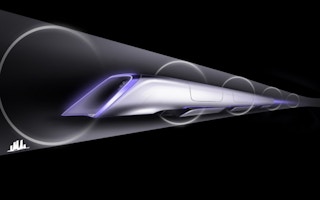Tesla Motors’ Elon Musk on Tuesday unveiled plans for the world’s fifth mode of transport - the long-awaited Hyperloop, a super fast and sustainable transportation system, in a 50-page document.
To continue reading, subscribe to Eco‑Business.
There's something for everyone. We offer a range of subscription plans.
- Access our stories and receive our Insights Weekly newsletter with the free EB Member plan.
- Unlock unlimited access to our content and archive with EB Circle.
- Publish your content with EB Premium.
An alternative to cars, boats, planes and trains, or the four regular means of travel, the Hyperloop is a highly anticipated design that comes a year after the electric car company leader announced his idea for an advanced type of transport. Musk proposed a solution combining the advantages of air and train travel that could be better than the approved high-speed rail network in California.
The California High-Speed Rail project, to be completed in 2029, is the first such rail system in the United States and it is intended to primarily connect travellers between San Francisco and Los Angeles in less than three hours.
However, in the Hyperloop document, Musk wrote how he was “quite disappointed” with the planned mass transit. He said, “How could it be that the home of Silicon Valley and [the Jet Propulsion Laboratory] – doing incredible things like indexing all the world’s knowledge and putting rovers on Mars – would build a bullet train that is both one of the most expensive per mile and one of the slowest in the world?”
The Hyperloop is his answer to this dilemma. Designed by engineers from Tesla and SpaceX, the space transport firm he co-founded, the cutting-edge transportation is an aboveground steel tube system with aluminium capsules or pods that zoom around carrying passengers at a speed of 760 miles per hour, or over 1,220 kilometres per hour.
This is faster than a bullet train or the California High-Speed Rail project that has an estimated rate of 200 miles per hour.
Musk also compared other factors between the Hyperloop and California project, as well as with other transport options, in the technical section of his design paper. He noted that while road travel may be inexpensive, it is slow and not so eco-friendly. Air travel, on the other hand, is expensive but fast, although not environmentally sound. Rail is likewise expensive, but slow. However, it is the greener option among the three.
Hyperloop, he underscored, is not a give or take of benefits. The design addresses all requirements of speed, cost and sustainability.
A large part of this is through the self-powering system incorporated in the design, using solar panels atop the tube, enabling the Hyperloop to generate more energy than it needs to operate. The energy is simply stored in battery packs that allow the pods to continue running at night or during days with cloudy or rainy weather.
More importantly, through the energy collected, the Hyperloop is able to move without rails. There will be an electric compressor system on the nose of the pod that will take in air, and channel it to the holes along the skis at the bottom of the pod. This creates a line of air cushion ‘lifting’ these capsules carrying the passengers. To move forward, magnets are also placed on the skis and an electromagnetic pulse is emitted by an electric motor similar to that of the Tesla Motor S sedan, albeit flat, found below it.
More electric motors will be positioned at each train stop to absorb the pods’ kinetic energy, in effect, slowing it down.
Aside from this clean technology and the renewable energy source, Musk also considered the resiliency and the impact of the Hyperloop system on the natural environment. The design of the tube system makes use of a system of pylons. With this, he said, “You can dramatically mitigate earthquake risk.” In addition, he explained, “A ground based high speed rail system is susceptible to earthquakes and needs frequent expansion joints to deal with thermal expansion or contraction and subtle, large-scale land movement.”
Trains on the ground also require vast amounts of land for clearance, foundations, and security fencing. This displaces people, animals and property and adds to visual and noise pollution.
The Hyperloop, with its sleek form raised high, will have minimal intrusion. It will also be safer. In the current design, it will follow the Interstate 5 route of the US’ West Coast, a highway that is one of the most travelled sections of the country.
While Musk will not develop the transportation system, he presented the plan as a viable alternative to the current California rail project. The aim is to have investors or interested parties to take the open design and implement it.
At this stage, Musk said, “This preliminary design study proposes a new mode of high speed transport that reduces both travel time and travel cost between Los Angeles and San Francisco,” unlike the California High Speed Rail.










